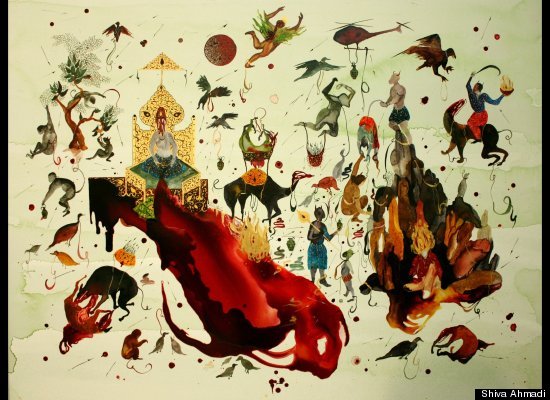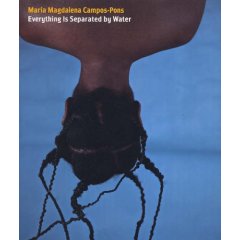I saw this on the Etsy page for Gregory Beauchamp
Islam is at the heart of an emerging global anti-hegemonic culture that combines diasporic and local cultural elements, and blends Arab, Islamic, black and Hispanic factors to generate "a revolutionary black, Asian and Hispanic globalization, with its own dynamic counter-modernity constructed in order to fight global imperialism. (say what!)
Showing posts with label art. Show all posts
Showing posts with label art. Show all posts
Thursday, December 02, 2021
Tuesday, August 30, 2011
Tuesday, March 15, 2011
Wednesday, August 25, 2010
man bites dog: buddhist fundamentalists and muslim prisoners of conscience
I totally missed this story when it happened but it seems worth noting as an example.
For the whole story, see: Author Sarah Malini Perera held ‘for offending Buddhists’ in Sri Lanka
The same piece mentions that the Sri Lankan government denied a visa to Muslim (yes Muslim) singer Akon because the video for his song Sexy Chick included images of video "vixens" dancing with a statue of the Buddha in the background. Part of the backlash included a crowd of over 200 angry rock-throwing Buddhists attacking the offices of Akon's concert promoters, damaging property and injuring a few individuals. You can find more details on that story here.
Both these stories, especially taken together, totally invert the usual narratives we are spoon-fed about religion and the tolerance/ sensitivity and peacefulness/ violence of Buddhism / Islam respectively. I'm a little surprised (but not really) that they didn't get more attention. A few more accounts like these and the dominant narrative would begin to crack. If members of a "good" religion like Buddhism can be pushed to violence when their sensitivities are threatened and if even Muslims can be victims of censorship and exclusion for acting on their conscience then who are the heroes and who are the villains?
An expatriate Sri Lankan woman who wrote two books about her conversion from Buddhism to Islam has been arrested while on holiday in Sri Lanka, apparently for causing offence to Buddhists.
Sarah Malini Perera, who was born in Sri Lanka but has lived in Bahrain since 1985 and converted to Islam in 1999, was arrested last week under the country’s strict emergency laws, according to the police.
They declined to give precise details of the 38-year-old writer’s offence, but suggested that her books were deemed to have caused offence to ethnic Sinhalese Buddhists, who account for about 70 per cent of Sri Lanka’s 20 million people.
For the whole story, see: Author Sarah Malini Perera held ‘for offending Buddhists’ in Sri Lanka
The same piece mentions that the Sri Lankan government denied a visa to Muslim (yes Muslim) singer Akon because the video for his song Sexy Chick included images of video "vixens" dancing with a statue of the Buddha in the background. Part of the backlash included a crowd of over 200 angry rock-throwing Buddhists attacking the offices of Akon's concert promoters, damaging property and injuring a few individuals. You can find more details on that story here.
Both these stories, especially taken together, totally invert the usual narratives we are spoon-fed about religion and the tolerance/ sensitivity and peacefulness/ violence of Buddhism / Islam respectively. I'm a little surprised (but not really) that they didn't get more attention. A few more accounts like these and the dominant narrative would begin to crack. If members of a "good" religion like Buddhism can be pushed to violence when their sensitivities are threatened and if even Muslims can be victims of censorship and exclusion for acting on their conscience then who are the heroes and who are the villains?
Sunday, October 14, 2007
everything is separated by water
A few weekends ago I was able to catch Everything is separated by water; an exhibition of 17 major pieces by María Magdalena Campos-Pons, an Afro-Cuban artist from Matanzas. I was stuck by how several of the pieces touched on questions of identity in a way which could be generalized to people of African descent, Latinos and immigrant Muslims. Whether you are talking about the Rio Grande, the Atlantic Ocean or the 90 miles which separate Miami from Cuba, 'everything' really is separated by water.
For the rest of the story, check out the Miami Herald: Cuban artist connects memories of a fragmented life
Memory, historical connections to Cuba and Africa, her dislocation and that of her ancestors fuel the 17 major works that comprise the Campos-Pons retrospective Everything is Separated by Water at the Bass Museum in Miami Beach.
''Her work is about constructing identity and cultural histories,'' says curator Lisa D. Freiman, who organized the retrospective for the Indianapolis Museum of Art, where it was staged more amply in 12,000 square feet of space. ``It's about who we become when we move to new places, and the feeling of not completely being whole in any place.''
'In my country, in my setting, in my town, `the problem' of being African wasn't about physical placement or about land,'' Campos-Pons explains. ``When we talked about Africa, we didn't talk about the continent. Africa was in my Cuban backyard.
''Africa was my father, my mother, my cousins and my aunts and uncles,'' she adds. ``They played the drums in the patio at all hours. The question of Africa arose from the point of view of the United States. When I was in Cuba, it was never a question.''
Using paint, herbs and wood sculpture -- sight, sounds and smells -- Campos-Pons conjures the image of the forest where the gods of santería are said to dwell. The forest also is the realm of their messenger and keeper of the roads, Eleguá, the orisha after whom Campos-Pons titles another work, The One Who Opens the Path (1997), a composition of 10 mammoth Polaroid Polacolor photographs.
Likewise, in another piece, The Seven Powers Come by Sea (1992), the seven orishas of the Yoruban pantheon are present in large wood sculptures that resemble slave ships and are carved with stick figures, showing how slaves were tightly stacked on ships sailing to the New World.
For the rest of the story, check out the Miami Herald: Cuban artist connects memories of a fragmented life
Labels:
afro-cuban,
afro-latino,
art,
identity,
water
Subscribe to:
Posts (Atom)


